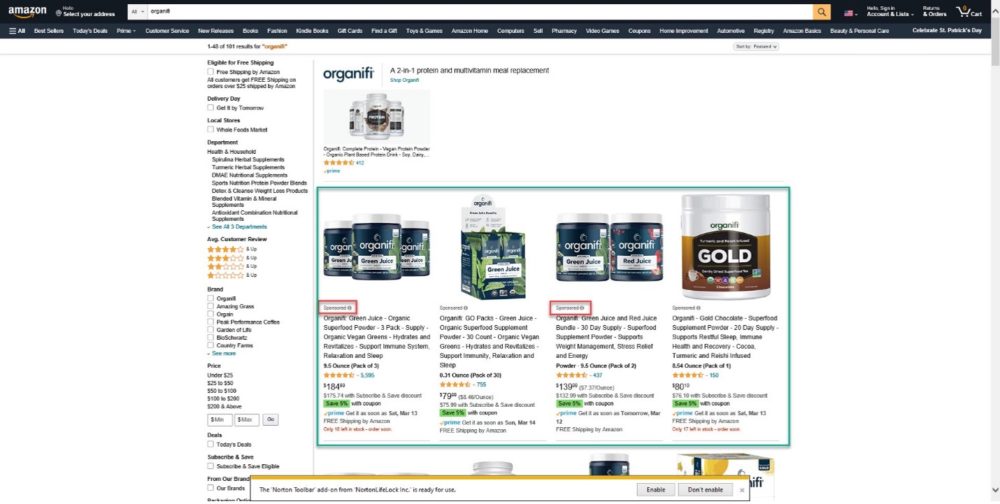
Building an Amazon marketing strategy from scratch is never easy but building it on top of another platform is sometimes even harder… Why? Because you can’t fully control the brand experience.
Selling on Amazon has its pros and cons. The site welcomes millions of visitors monthly, which for most of us is the kind of traffic we could only dream of. It streamlines the selling process, making the experience smooth and easy for newcomers and experts alike.

Amazon also has a fantastic reputation, built up over years of hard work. By becoming a seller on Amazon, you can feel the benefits of that reputation.
But now for the cons. When you join Amazon, you open your business and your product to a world of new opportunities… at a price. The platform charges many fees, and it also has rules that its sellers must follow.

These rules can affect many areas of your business, even down to your product image and description. This means that Amazon sellers need to add a new element to their marketing strategies—Amazon tactics.
Creating A Complete Amazon Marketing Strategy
An Amazon seller’s first obstacle is cutting through the noise. You need a strategy for properly marketing on Amazon while also following marketplace rules. Here are a few basics you should work through to create a solid Amazon marketing strategy.
- Create a strong brand identity. What are you selling, and to whom?
- Create an Ideal Customer Profile (ICP).
- Choose relevant keywords. Incorporate these keywords into your title.
- Use SEO to drive traffic to your site.
- Use email marketing to turn one-time customers into repeat customers.
- Make sure your products are highly rated and well-reviewed. Amazon is more likely to promote popular content.
- Create social media content to link back to your website. This is something that should work closely with your brand identity and positioning.
- Conduct thorough competitor analysis and stay abreast of how your competitors are doing via customer reviews and social media.
- Invest in internal promotions.
Amazon may be a thriving marketplace, but you’ll still encounter stiff competition. Details matter. So how should you go about creating your Amazon marketing strategy?
Start by identifying your potential buyers. Who are you aiming at, and more importantly, how can you reach them? Can you tweak your product description and titles to appeal to those customers? These questions will shape your Amazon marketing strategy.
Becoming a top-rated seller, investing in Amazon ads, or paying attention to keywords and SEO will all help your product rise through the listings. Your aim is to get Amazon to promote your product.
It’s not complex, but strategic. Just think like an Amazon marketing strategy pro by considering how your content can influence your sales. After all, your Amazon marketing strategy should get results.
Now that you have background information about building an effective Amazon marketing strategy, let’s discuss the fundamentals of creating a marketing plan. Our goal is to take your business to new heights using a focused Amazon marketing strategy that sells your products.
The Fundamentals Of Marketing Your Amazon Brand
If you skip Amazon marketing strategy basics, you’ll have a difficult time selling on Amazon’s platform. Without a strong marketing foundation, buyers will have a challenging time understanding why they need your products instead of your competitors.
The last thing you want is for people to ask about things your company doesn’t offer, essentially wasting your time. That’s why you must craft an exceptional Amazon marketing strategy.
Creating a brand identity is crucial to stand out on Amazon’s platform. This involves more than just adding a logo to your product. Every detail needs to fit into your chosen brand, so you must follow an Amazon marketing strategy to succeed.

You need to have a solid brand identity created before you begin marketing that brand.
Proper brand marketing involves building a relationship with your customers. Sales shouldn’t be the main focus, although a successfully marketed brand will undoubtedly sell itself.
There are a few main steps to marketing any brand:
- Know Where You’re Going
What is your vision for your brand? Right at the beginning, create a mission statement of what you hope to achieve with your product. Expand on your product offerings to match your brand. Add it to your Amazon marketing strategy goals. - Know Your Audience
Who are your customers, and how can you better appeal to them? Create an ideal customer profile to help you identify your top prospective buyers. This information should always be highlighted in your Amazon marketing strategy. - Create A Brand Identity
Brand identity is a vital element of your Amazon marketing strategy and it’s all about the look of your product. It includes the packaging, the colors, the logo, and more. It also consists of the imagery involved in your brand, the type of social media content you create, and the influencers you choose to promote your brand. - Send A Message
We all know how powerful advertising can be. But a vague and confusing Amazon marketing strategy missing product listing isn’t going to help anyone. What are you trying to convey to your customer about your product? What benefits will it bring, and how will it make them feel? - Be Consistent
None of these things will do your brand any good if you aren’t consistent. An inconsistent brand won’t get established in its customers’ minds at all, and a product that doesn’t deliver will simply get passed over.
There’s a lot of work involved in these few necessary steps. Amazon sellers should implement all these suggestions in their brand, but there are a few more points to think about. But one of the most essential rules of Amazon marketing strategy is to be consistent. That’ll remains the same. - Create An Effective Launch Plan.
A new product on any platform, Amazon included, isn’t going to get customers very excited without a strategy. You need to build interest in your product before and after it’s released. To do this, create a plan for launching new products that creates demand for your products.

- Consider Your Packaging
Eco-friendly brands often pride themselves on unique packaging, which is excellent for a brand identity. However, Amazon has specific rules on packaging, and if you don’t abide by their rules, your packages may get stopped at the Amazon warehouse. Always do your research first while crafting your Amazon marketing strategy. - Conduct Competitor Analysis
This may already be something you’re doing, which is excellent. This is especially important on Amazon due to the high level of competition. Information on competitors is readily available from customer reviews and Q&A pages. Gather this information, as it influences your Amazon marketing strategy. - Create Sales Funnels
Email marketing, promotions, and giveaways are great ways to build loyalty and repeat customers. This requires an online marketing system that’s separate from your Amazon marketplace store, but it can enhance how much you sell on the platform, or on your own website.
So, there you have various strategies for improving your brand, both on and off Amazon. These tips will help you connect with your Amazon target market and increase your sales. Now that we’ve set some Amazon brand guidelines that explain what you can do to sell more on this marketplace, let’s discuss marketing on Amazon further.
3 Amazon Marketing Strategy Assets You Need To Get Started

Marketing is all about documenting and applying brand guidelines consistently while answering to your prospects’ true needs and wants. And it’s a constant process.
A new business might want to keep its brand guidelines simple, but as your business grows, you’ll likely need to improve your policies. Most companies create manuals or documents, including their brand guidelines, as a vital touchpoint in their decisions.
Remember, there are lots of details to consider when presenting a brand and creating an Amazon marketing strategy. Having proper documentation to refer to can be a lifesaver when you’re unsure whether an influencer is right for your brand!
Brands can change and evolve over time, and this is ideal. It means that your product can keep up with trends.
You may want to update your brand guidelines as your brand changes. Perhaps your logo is outdated and doesn’t translate well to digital formats, or maybe your mission statement is no longer relevant. This can mean your whole brand is due for an overhaul.
Make sure that you improve your brand frequently. Major companies like Pepsi, Google, and Facebook do it. Even if your brand isn’t as large as these companies, your brand must also adapt to changing preferences to continue selling products. The purpose of continual improvement starts in your Amazon marketing strategy.
Which 3 Key Marketing Assets Should You Focus On?
There are many details to consider in creating an Amazon marketing strategy for your product, and it can get a little overwhelming. However, there are three main assets you need to consider. These three points are the cornerstone of any good Amazon marketing strategy.
Marketing Asset #1: Ideal Customer Profile (ICP)

You want your product to appeal to as many people as possible. But the fact is, products that appeal to a middle-aged businessman likely won’t appeal to a pre-teen.
This means that you will need to use distinct brands and marketing techniques for each customer. Using the wrong strategies will push customers away from your product, not towards it.
Firstly, what kind of product are you selling? Who do you think it would appeal to? Look at your current sales and work out what your customers have in common.
Use what data you can, such as geographic locations, demographics, and preferences. Then build an ideal customer profile for your product categories. This will help you identify the people you should target in your brand’s messaging.
If you identify that your buyers are women between the ages of 34 – 55, you can use this information to speak directly to their needs. Without building an ideal customer profile, you won’t know what their pain points are and why they need your products to solve their problems.
With an ICP, you can craft the perfect marketing message to convince your audience that they need your products. The first step in marketing your products is to understand the needs of your ideal customers, so start here.
Marketing Asset #2: Brand Positioning
Now that you’ve created your ICP, it’s time to use that information. What do your customers want? How can you appeal to your chosen demographic?
Your ICP is something you should consider when positioning your brand. Whether you’re creating content, advertisements, or updating your brand, always consider your customers’ wants and needs.
For example, a brightly colored, action-packed promotion aimed at children won’t appeal to adult professionals. Thus, it’s important to build a brand that your customers can relate to.
Some buyers want eco-friendly products, others want items produced in the United States, and others want affordable products without caring about anything other than cost. By understanding your buyers, you’ll be in a strong position to develop a brand that matches your prospective customer’s needs.
Marketing Asset #3: Tone Of Voice

Your ICP will also affect your brand’s tone of voice. This means the way you address your customers.
For example, your brand may use serious or very formal language. Or you may use informal language, with colloquialisms and modern slang.
Neither of these tones is wrong, presuming that it appeals to your chosen audience. If your audience is young people, stiff and wordy styles will likely put them off.
As always, consistency is vital. The tone of voice is part of your brand identity and should be included in the brand guidelines.
Both in the early stages and later on, marketing involves a lot of strategic work. Skipping all or part of this work will lead to significant misalignments and confusion down the line.
Fortunately, we’re here to help you identify an Amazon business strategy and tactics that can enhance your brand and increase your sales on Amazon. Now that you have a background of how an Amazon marketing strategy begins, let’s discuss the specifics of marketing on this major online marketplace.
What’s Unique To Marketing An Amazon Brand?
A lot of what happens on Amazon is very similar to any other eCommerce website out there. The difference is that Amazon enjoys direct traffic from millions of people every month.
In fact, Amazon is easily the most successful eCommerce website around. The ease of buying, selling, and returning has contributed to the Amazon “ecosystem.”
A seller who successfully employs a solid Amazon marketing strategy can enjoy incredible sales success. Competition on Amazon is certainly stiff, but there are endless opportunities.
New sellers are continually joining, and hordes of new customers come to buy every month. This keeps the marketplace fresh and relevant.
Amazon also employs unique and helpful elements, such as embedded ads, listing optimization, customer reviews, and FAQ pages.

Embedded ads can be a vital tool to promote a product, and a creative Amazon seller can quickly rise through the listings. This means that as they sell more and become popular sellers, Amazon will promote them further.
Reviews and FAQs are essential to keeping an eye on your customers – and on your competitors. Be sure to regularly review your FAQs to check that there are no issues with your products.
Tactics such as Social Media Marketing (SMM) aren’t part of the ecosystem, meaning that it doesn’t directly contribute to the Amazon marketplace. However, that doesn’t mean you can’t use it to your advantage.
Social media is an incredible tool to draw attention to your brand, and you can always link back to your Amazon page.
In marketing, the tactics aren’t as important as the overarching brand strategy. You want to make sure you have that down first before heavily investing in ads, SMM, content, and more.
Bad advertisements or off-brand SMM can do severe harm to your brand. We’ve already mentioned the importance of a product launch and generating excitement for a new product since it’s all too easy to get missed out in a thriving marketplace.
You should have your brand identity and vision planned out before you begin planning ads, SMM, and other content. Although these strategies don’t take place only on the Amazon marketplace, using SMM, ads, and brand identify to your advantage will help you improve your sales on this platform.
Your Marketing Efforts Enhance Your Brand’s Reputation
Your brand is a living and breathing thing, you can’t replace it, even if you’re “just” selling on Amazon. However, it is harder to control the full brand experience on the platform.
It comes as no surprise to learn that most product categories are saturated. Do you sell vegan, cruelty-free, organic, eco-friendly makeup for sensitive skin? That may seem like a niche product, but in fact, you’re swimming in competition.
This means that brand management is critical. Price can be a deciding factor for some customers when deciding between two comparable products, but brand identity will positively influence buyers more than cost.
Can marketing really help you manage your brand? You may be skeptical since marketing is geared towards concrete business strategies, whereas brand creation and management focus almost entirely on how you present yourself and your product.
Marketing helps bring your brand to the attention of customers. In a traditional, crowded marketplace, the seller who shouts the loudest attracts the most customers.
Managing a brand and creating marketing strategies are not easy tasks. However, there are services such as Emplicit, which can help with marketing and manage your brand. We specifically help Amazon sellers looking to improve and better market their brand.
To learn more about Amazon strategy and develop your brand’s plan for winning on Amazon in 2022, please contact Emplicit, a top-tier, results-driven Amazon marketing Agency for growing eCommerce brands. And don’t forget about our success quiz, where you can see how your brand compares to the competition.

